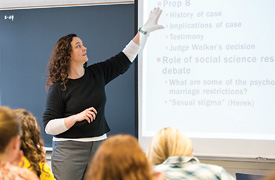
New faculty members who participate in a program to enhance teaching report greater confidence in their abilities in the classroom and more involvement in professional development activities. Student evaluations of those faculty members also reflect better learning.
Each year LSA welcomes many new junior faculty members from across the country and the world. The hiring process is painstaking and the competition stiff as LSA seeks to hire the best and brightest young scholars.
But bringing new faculty to campus is only the first step. Having them achieve excellence at Michigan, building distinguished careers of teaching and scholarship, is the ultimate goal.
The LSA Teaching Academy represents one investment the college makes to help new faculty thrive. Based on the results of a recent study by the Center for Research on Learning and Teaching (CRLT), this investment is paying off handsomely, leaders say.

Sara McClelland, assistant professor of psychology and women’s studies, teaches a class on Sex, Sexuality & Public Policy . McClelland participated in the LSA Teaching Academy in fall 2012. She said she found the assistance offered in course planning most helpful. Photo by Austin Thomason, Michigan Photography.
LSA Dean Terrence McDonald initiated the Teaching Academy in August 2009. The program, a collaboration between LSA and CRLT, is required of all new assistant professors in the college, regardless of prior teaching experience. Faculty members are compensated for their participation.
“We want to communicate to new faculty the importance the college places on teaching — especially at the undergraduate level,” McDonald says. “And we want to make available to them the tools they need to really hit the ground running and succeed in the classroom.”
The goals of the program include introducing faculty to U-M students, deepening their understanding of how students learn, and what teaching strategies best promote student success. (A full list of goals can be found in the accompanying box.)
Beginning with a two-day session in August, the program continues throughout a junior faculty member’s first year at the university. It includes opportunities for advice about course planning from outstanding teachers in their disciplines, discussing ways to incorporate technology into courses, and collaborating with CRLT consultants to gather and respond to student feedback during their first semester of teaching at U-M.
Goals of the LSA Teaching Academy and what new faculty members say about how it helps them accomplish those goals.
Value good teaching: “It was heartening to see how dedicated the university is to teaching.”
Deepen understanding of how students learn: “I learned more about the latest educational research than in all my years of graduate school.”
Gather strategies for teaching: “I will definitely try some of the concrete suggestions I got regarding active learning.” “I came from another faculty position and wasn’t sure if I’d find it useful, but it really was. Thank you!”
Learn about U-M students: “The session topics nicely introduced us to the expectations of Michigan students and the teaching culture at Michigan.”
Learn about U-M resources and policies: “I have a new (and better) perspective on how to deal with various student issues.” “It was wonderful to have representatives from the dean’s office answering questions.”
Calibrate courses to U-M context: “I actually made some major changes to my syllabus for my grad seminar.”
Develop a cohort: “The workshop was very valuable for the camaraderie and introductions alone.”
To gauge the impact and effectiveness of the academy, CRLT recently conducted a study drawing on diverse data sources: participant surveys, engagement with CRLT-sponsored educational-development activities and student evaluations. The study indicates that the academy is making a difference in several ways. First, members of the Teaching Academy express greater confidence in their readiness for a variety of teaching-related tasks after the August intensive session than before.
Second, members of the Teaching Academy are more likely to participate in professional development activities focused on teaching, such as attending teaching seminars and requesting facilitated midterm student feedback sessions in their courses, compared to earlier cohorts of faculty.
Finally, students of professors who participated in the Teaching Academy were more likely to agree that they “learned a great deal from this course,” even after controlling for other variables known to influence student ratings.
These results indicate that the academy is helping faculty make a successful transition to teaching at U-M. And, as CRLT Executive Director Constance Cook points out, the impact of the program has been huge.
“The 89 faculty in the first three cohorts of the Teaching Academy have taught 504 classes involving 18,781 students. Clearly, the Teaching Academy has made a significant contribution to teaching and student learning in the college,” Cook says.
Goals of the LSA Teaching Academy and what new faculty members say about how it helps them accomplish those goals.

